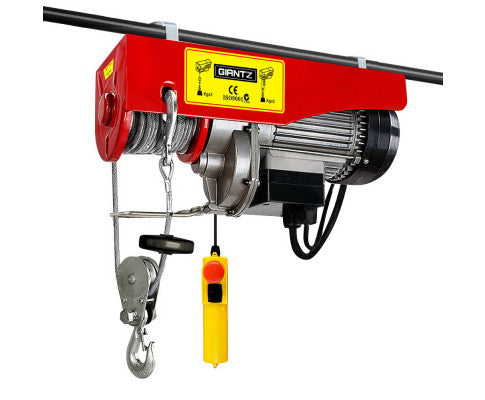sales@tecnotools.com.au
sales@tecnotools.com.au
Call us: 0433 734 100

Material handling is a crucial aspect of many industries, ranging from manufacturing and construction to warehousing and logistics. Electrical hoists have played a pivotal role in revolutionizing the way we lift and move heavy loads. These devices have undergone significant advancements in recent years, leading to improved safety and efficiency in material handling processes. In this article, we will delve into the latest developments in electrical hoists and their impact on various industries.
Safety has always been a paramount concern in material handling. Electrical hoists have evolved to address these concerns by incorporating advanced safety features. One of the most significant innovations is overload protection systems, which prevent hoists from lifting loads beyond their rated capacity. This feature not only safeguards the equipment but also ensures the safety of workers and bystanders.
Electrical hoists now come equipped with emergency stop functions, ensuring rapid cessation of operations in case of unforeseen circumstances. These advancements have significantly reduced the risk of accidents and injuries in material handling applications.
With the increasing demand for lifting heavier loads, electrical hoists have seen substantial improvements in load capacity. Modern hoists are designed to handle a wider range of weights, making them suitable for a variety of applications. These enhancements have led to increased versatility and adaptability in material handling, allowing for more efficient use of resources and manpower.

Efficiency is a top priority for any industry. Electrical hoists are now incorporating energy-efficient technologies, such as regenerative braking and variable frequency drives. Regenerative braking harnesses the energy generated during the hoist's descent and converts it into electricity, which can be reused or stored. Variable frequency drives enable smoother acceleration and deceleration, reducing wear and tear on the equipment and saving energy.
These energy-efficient features not only reduce operational costs but also contribute to a greener and more sustainable work environment.
The ability to control hoists remotely has transformed the way material handling operations are conducted. Many electrical hoists are now equipped with remote control options, allowing operators to manage the equipment from a safe distance. This is particularly beneficial in applications where precision and safety are paramount, as it eliminates the need for personnel to be in close proximity to the load being lifted.
Additionally, remote monitoring and diagnostics are becoming more commonplace, enabling real-time feedback on the condition and performance of the hoist. This proactive approach to maintenance enhances overall operational efficiency and minimizes downtime.
Suggested Article: The Different Types of Hoists
Electrical hoists offer advantages to a wide range of industries by enhancing efficiency, safety, and productivity in material handling. Some of the industries that benefit the most from electrical hoists include:
Manufacturing: Electrical hoists are commonly used in manufacturing facilities to move heavy materials and components on production lines. They increase productivity by reducing manual labor, minimizing the risk of accidents, and enabling precise positioning of objects in assembly processes.
Construction: The construction industry relies on electrical hoists for lifting and positioning heavy construction materials, equipment, and even workers. Hoists are used in tasks like concrete pouring, steel structure assembly, and material transportation at construction sites.
Warehousing and Logistics: In warehouses and distribution centers, electrical hoists are essential for moving and stacking goods, often in high-rise storage configurations. They streamline order picking, loading, and unloading processes, reducing handling time and improving inventory management.
Automotive: In the automotive industry, electrical hoists are used for engine and transmission assembly, lifting vehicle components, and transporting heavy parts throughout the production process. They contribute to efficient manufacturing and quality control.
Shipbuilding and Maritime: Shipyards and maritime industries utilize electrical hoists for lifting and positioning large ship components, engines, and heavy maritime equipment. The precision and safety provided by hoists are crucial in this sector.
Aerospace: The aerospace industry relies on electrical hoists for the assembly of aircraft components and engines. Hoists ensure precision and safety during the manufacturing process and assist in the handling of delicate and heavy aerospace materials.
Mining and Resources: Electrical hoists are commonly used in mining operations to lift and transport heavy materials and equipment in underground and surface mining environments. They enhance safety and reduce manual labor in a demanding industry.
Oil and Gas: The oil and gas sector employs electrical hoists for various applications, including lifting equipment and materials on drilling rigs, offshore platforms, and refineries. Hoists play a critical role in maintaining operational efficiency and safety in this industry.
Renewable Energy: Electrical hoists are used in the installation and maintenance of renewable energy infrastructure, such as wind turbines and solar panel arrays. They aid in lifting and positioning components at heights and remote locations.
Entertainment and Theatre: The entertainment industry uses electrical hoists for stage rigging, lighting, and set design. Hoists assist in the precise and controlled movement of equipment, props, and stage elements, ensuring safe and dynamic performances.
Electrical hoists have come a long way, and their continuous evolution has transformed material handling practices across different industries. The integration of safety features, increased load capacity, energy-efficient technologies, and remote control options has not only improved the efficiency of operations but also enhanced the safety of workers and the integrity of equipment. As technology continues to advance, electrical hoists will remain at the forefront of innovation, ensuring the future of material handling is safer and more efficient than ever before.
Do not hesitate to get in touch with TecnoTools if you would like to know more about our range of hoist an winches for the industry and automotive.